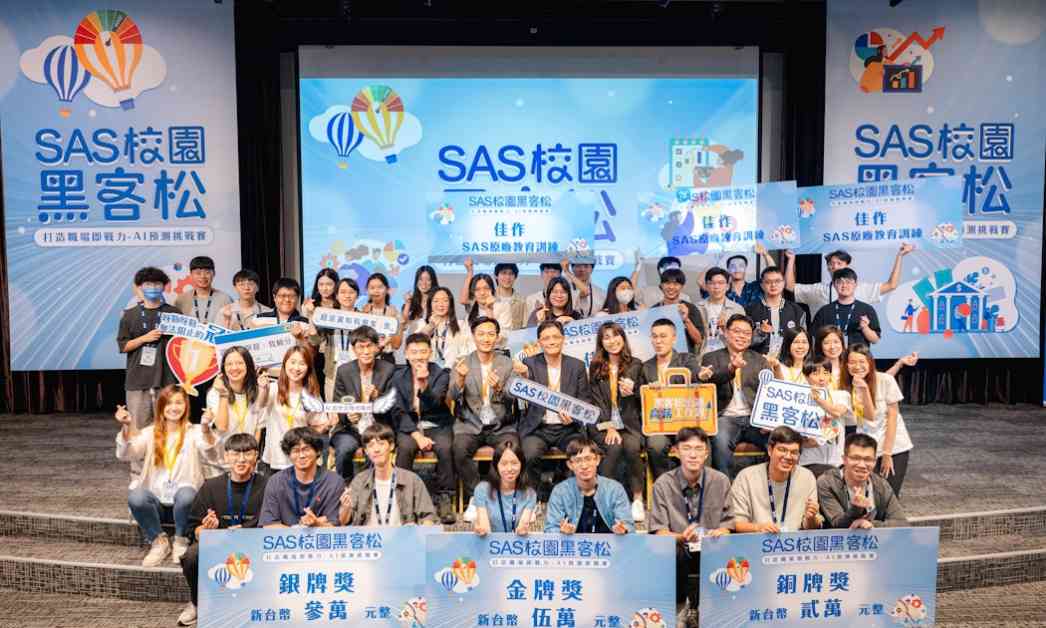SAS Viya, a leading global analytics platform, recently organized a campus hackathon focusing on AI prediction challenges to empower future data scientists and enhance students’ competitiveness in the financial industry. The event attracted over 200 students from more than 40 universities and colleges in Taiwan, representing a 50% increase from the previous year.
The rapid development of AI technology is evident, with the International Data Corporation (IDC) predicting that global AI spending will reach $110 billion by 2024, with a compound annual growth rate (CAGR) of 20.1% from 2019 to 2024. According to Chen Xinquan, Vice General Manager of SAS Taiwan’s Business Consulting Department, this year’s competition showcased students’ remarkable creativity and analytical skills, demonstrating the increasing maturity of AI foundational skills on campuses. As the concept of composite AI continues to evolve rapidly, incorporating various AI technologies such as machine learning, natural language processing, and large language models is essential for maximizing their utility in enterprises.
SAS has always emphasized innovative applications, and to provide students with a deeper understanding of composite AI applications, real-world industry cases in food safety and inventory logistics were referenced. Through collaboration with the Chicago Department of Public Health, SAS utilized a composite AI framework to address complex issues in food safety management, successfully implementing risk grading and visualizing high-risk restaurants while providing improvement suggestions using generative AI. Similarly, in the inventory logistics field, SAS applied generative AI, optimization, and predictive analytics to assist global food industry players in optimizing inventory and establishing a logistics AI assistant system.
In line with SAS’s commitment to innovation, the competition simulated real-life banking scenarios where participants acted as data analysts responsible for handling auto loan businesses. Teams used the SAS platform to develop precise predictive models. The competition comprised preliminary and final stages, with participants tasked with predicting a list of customers willing to lend in the preliminary round. The top 12 teams advanced to the finals, where they presented their analyses and problem-solving abilities.
The competition culminated in the “Goal for Prize” team winning the bronze medal by incorporating macroeconomic variables into their innovative application scenario, impressing the judges. The silver medal went to the “SAS Give” team, which combined blockchain and generative AI technologies to create a novel “dynamic premium pricing model” application scenario. The gold medal was awarded to the “YC” team comprising students from Tsinghua University and Central University, who highlighted the efficiency of SAS Viya in handling large datasets and aiding in their analysis process within a tight timeframe.
Apart from lucrative cash prizes, winners of the SAS campus hackathon have the opportunity to receive SAS’s original education training and corporate internship opportunities, paving the way for their future careers. As an integrator of generative AI and decision-based AI, SAS not only creates its own enterprise applications but also aims to continuously cultivate data science talents with AI proficiency in Taiwan through such industry-academia collaboration models, fostering new applications of composite AI and injecting fresh momentum into the industry’s digital transformation.
In conclusion, the SAS campus hackathon serves as a valuable platform for students to showcase their analytical skills and innovative thinking in solving real-world business challenges. By leveraging the SAS Viya platform and exploring composite AI applications, participants gain practical experience and prepare themselves for the evolving landscape of data science and analytics in the financial industry. SAS’s commitment to fostering talent and driving innovation underscores its dedication to advancing the field of AI and empowering the next generation of data scientists.












